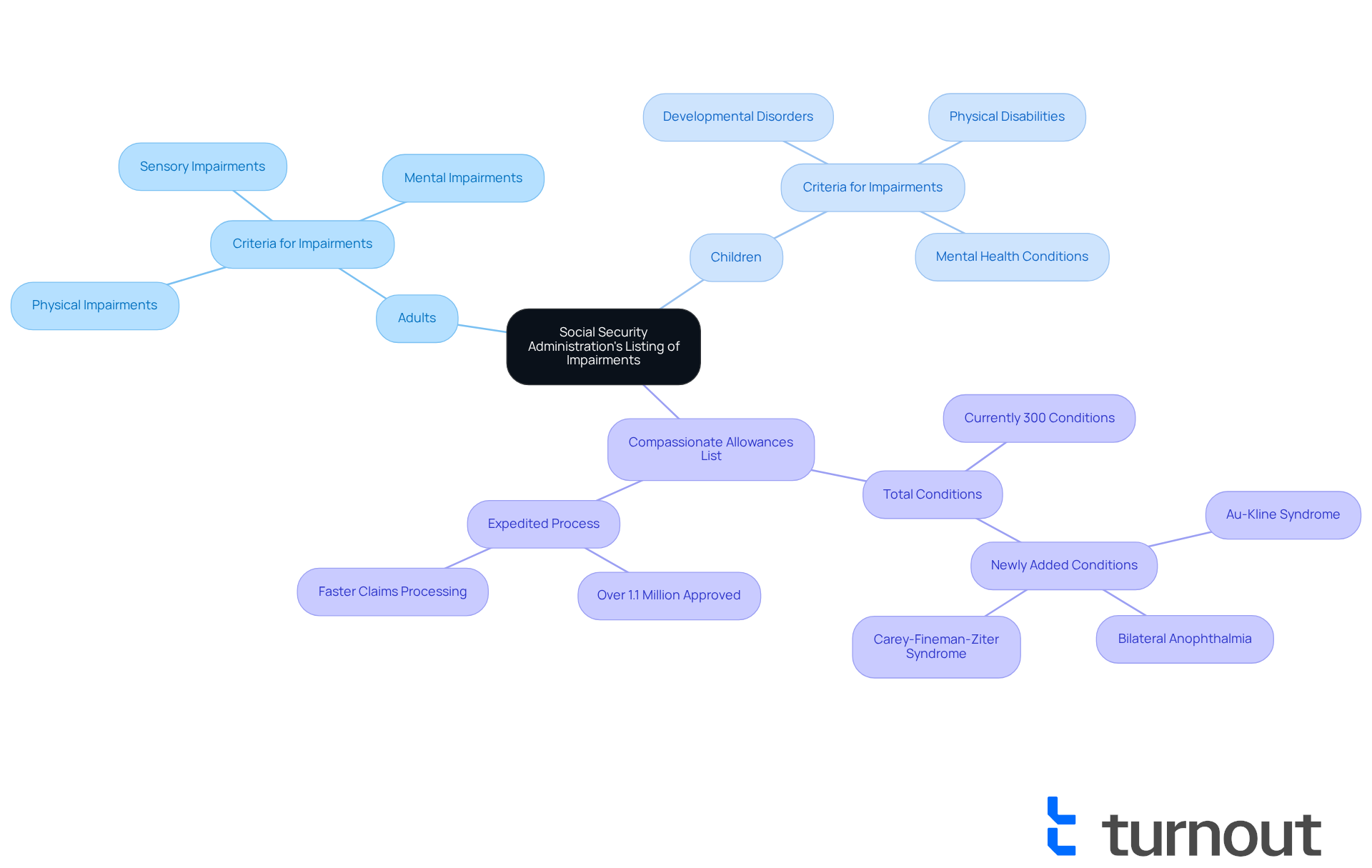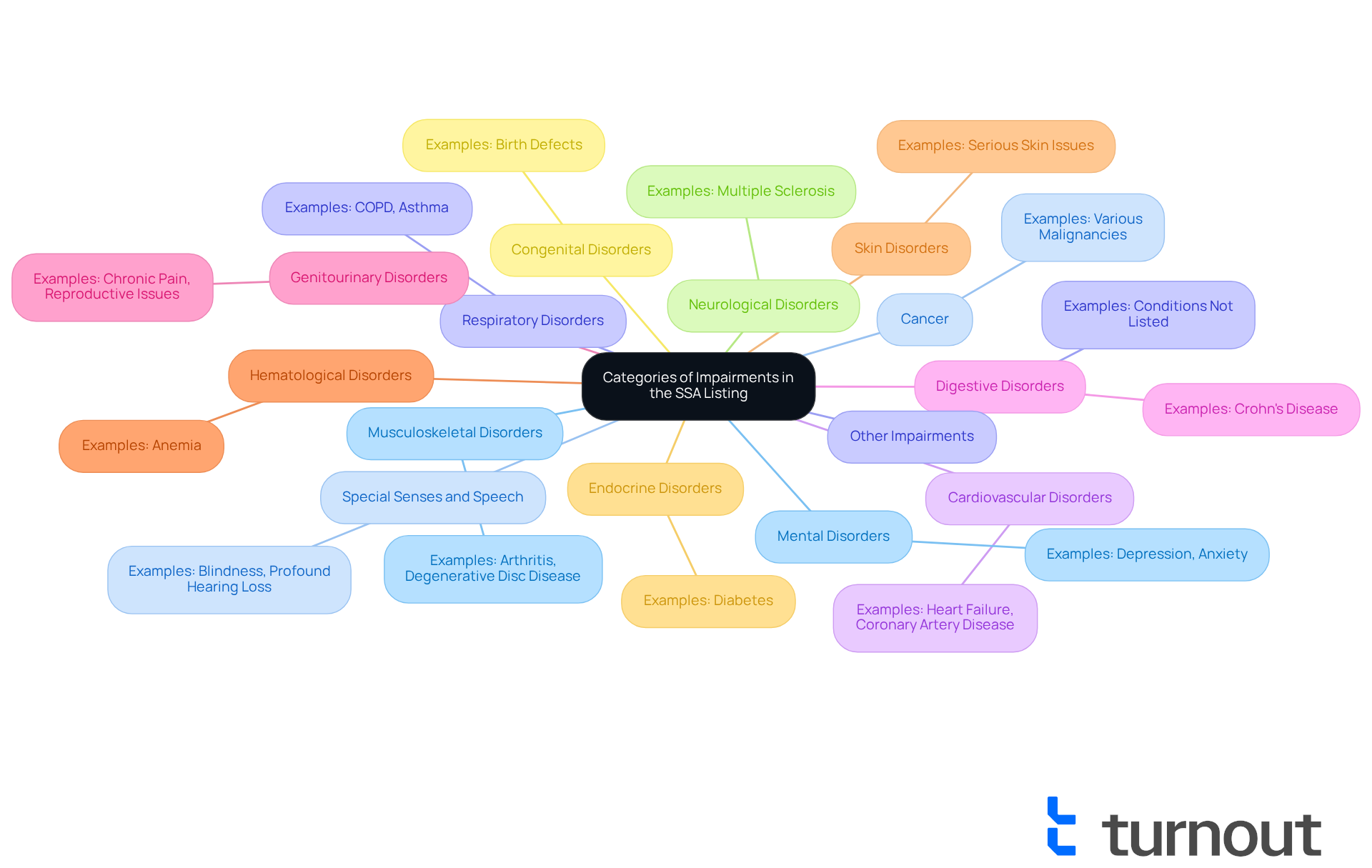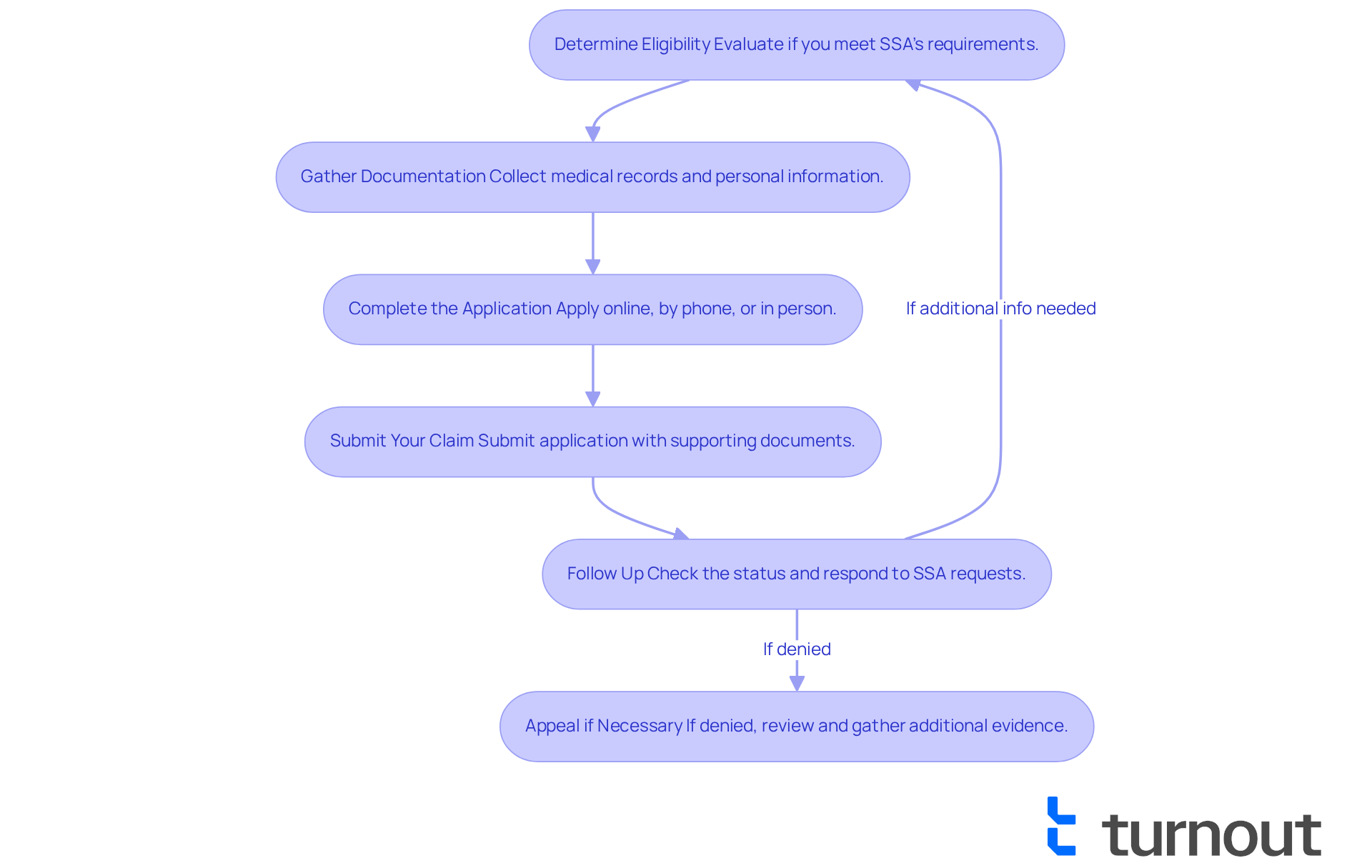Overview
Navigating the Social Security Administration's (SSA) Listing of Impairments can feel overwhelming. We understand that determining eligibility for disability benefits is a significant concern for many. This article aims to guide you through this process with care and compassion.
Understanding the detailed criteria outlined in the Blue Book is essential. Gathering comprehensive medical documentation is another crucial step. These actions can significantly enhance your chances of a successful application for Social Security Disability Insurance (SSDI) or Supplemental Security Income (SSI).
Remember, you're not alone in this journey. We’re here to help you every step of the way. By taking the time to familiarize yourself with these requirements, you are empowering yourself to navigate the system more effectively.
Introduction
Understanding the Social Security Administration's Listing of Impairments is crucial for millions seeking disability benefits. We recognize that navigating this complex system can feel overwhelming. This comprehensive guide breaks down the intricate categories and criteria outlined in the 'Blue Book,' illuminating the path toward successfully navigating the application process. As more Americans rely on Social Security Disability Insurance, the stakes have never been higher.
How can you ensure you meet the necessary requirements and avoid common pitfalls that could jeopardize your claims? You're not alone in this journey, and we're here to help you every step of the way.
Overview of the Social Security Administration's Listing of Impairments
The Social Security Administration (SSA) publishes a detailed , commonly known as the '.' This important document categorizes various health issues that can significantly hinder a person from engaging in meaningful productive activity. It is a vital reference for determining eligibility for Insurance (SSDI) and Supplemental Security Income (SSI). The Blue Book is thoughtfully organized into two main sections: one for adults and another for children, each specifying the criteria that must be met for different impairments. is crucial for determining your potential eligibility for benefits based on your health status.
As we approach 2025, around 8.5 million Americans are receiving SSDI benefits, which underscores the . The SSA's Blue Book not only shapes the application process but also provides a structured way for applicants to demonstrate their eligibility. Disability advocates emphasize that the Blue Book is essential for ensuring that individuals with qualifying conditions receive the . By navigating the complexities of the Blue Book, you can , ultimately leading to that are so crucial for your well-being.

Categories of Impairments in the SSA Listing
Understanding the is essential for individuals seeking . This listing is thoughtfully organized into 14 major categories, each representing a distinct body system. Recognizing these categories can profoundly impact your eligibility and the support you receive.
- : Conditions affecting bones, joints, and muscles, such as arthritis and degenerative disc disease, can significantly limit mobility and daily activities. It’s common to feel overwhelmed by these challenges.
- Special Senses and Speech: Impairments related to vision and hearing, including blindness and profound hearing loss, can hinder communication and interaction with the world around you.
- Respiratory Disorders: affect your ability to perform physical tasks, often leading to disability claims. We understand how these limitations can shape your daily life.
- : Heart-related issues, including heart failure and coronary artery disease, can restrict physical exertion and overall health, making it vital to address these concerns.
- Digestive Disorders: Issues affecting the gastrointestinal tract, such as Crohn's disease, can lead to significant health challenges that disrupt daily functioning.
- Genitourinary Disorders: Conditions impacting the urinary and reproductive systems can cause chronic pain and other debilitating symptoms, affecting your quality of life.
- Hematological Disorders: Blood disorders like anemia can have serious health implications, influencing your energy levels and overall well-being.
- Skin Disorders: Serious skin issues can restrict functioning and affect both physical comfort and social interactions, which is understandably distressing.
- Endocrine Disorders: Conditions like diabetes disrupt hormone production, often requiring ongoing management and impacting your daily life.
- Congenital Disorders: Birth defects that affect bodily functions can lead to lifelong challenges, and it’s important to seek support.
- : Issues impacting the nervous system, such as multiple sclerosis, can result in considerable functional limitations that require understanding and compassion.
- : Psychological issues, including depression and anxiety, underscore the significance of mental health in disability assessments. You are not alone in this struggle.
- Cancer: Various malignancies may qualify based on severity, reflecting the critical nature of cancer-related disabilities.
- Other Impairments: This category includes conditions that don’t fit neatly into the above classifications but are still considered disabling.
Each category has specific criteria that must be met for your request to be approved. For example, impairments must last or be expected to last for at least 12 months to qualify. Familiarizing yourself with the social security administration listing of impairments is crucial, as it can significantly influence the likelihood of approval for disability benefits. Remember, we're here to help you .

Evidence Requirements for Disability Claims
Effectively managing the application process for Social Security Disability benefits can feel overwhelming. We understand that presenting thorough health documentation is essential to support your claim. At Turnout, we are dedicated to simplifying access to government benefits and financial support, guiding you as you .
The Social Security Administration (SSA) requires several key components of medical documentation:
- : Detailed documentation from healthcare providers that outlines your diagnosis, treatment history, and prognosis.
- Objective Evidence: This includes test results, imaging studies (such as MRIs or X-rays), and other diagnostic tools that validate your impairment.
- Functional Limitations: Statements from healthcare professionals detailing how your impairment affects your ability to perform daily activities and work-related tasks.
- Treatment History: A record of ongoing treatment, including medications, therapies, and any surgeries you have undergone.
- Statements from Others: Supportive statements from family members, friends, or caregivers that describe how your impairment impacts your daily life.
Gathering and presenting this evidence accurately is crucial, as it forms the backbone of your disability claim and can significantly influence the outcome. Many individuals who have successfully navigated the SSDI process emphasize the in their approval. Claims backed by comprehensive health documentation tend to have a greater chance of success, as the requires clear evidence that an ailment hinders substantial gainful activity.
As we approach 2025, it's important to be aware of the . This includes the necessity of a Source Statement detailing how your condition affects your work capabilities. When supported by impartial test outcomes and reliable health records, this assertion can significantly improve the strength of your disability request. Therefore, starting to create a thorough and consistent health record as soon as possible is vital. The SSA application process can extend for months, and appeals may take even longer.
Additionally, verifying work credits and monitoring income levels are critical components of the SSDI application process that you should not overlook. Remember, you are not alone in this journey. are here to assist you in navigating these complexities, ensuring you have the support needed to present a strong claim.

Navigating the Application Process for Social Security Disability
Navigating the for can feel overwhelming. We understand that this journey is filled with uncertainty and concern. However, knowing the can make the experience much more manageable. Here’s a step-by-step guide to help you through:
- Determine Eligibility: Start by evaluating whether you meet the eligibility requirements outlined in the social security administration listing of impairments, which include a sufficient work history and the seriousness of your health issue. It’s important to stay informed, especially with .
- Gather Documentation: Collect all necessary medical records, evidence of your condition, and personal information for the application. Thorough documentation is vital, as approximately 62% of initial SSDI applications are denied nationwide. Remember, you are not alone in this process.
- Complete the Application: You can apply online through the SSA website, by phone, or in person at your local SSA office. Ensure that all information is accurate and complete to avoid delays. Take your time; this is an important step.
- Submit Your Claim: After filling out the application, submit it along with all supporting documents. Keep copies of everything for your records. This will be helpful in case of any follow-up inquiries.
- Follow Up: After submission, keep an eye on the status of your request. The SSA may request additional information or clarification, so be prepared to respond promptly. It's common to feel anxious during this waiting period. Currently, are around 7-7.5 months, which is significantly longer than pre-pandemic levels.
- Appeal if Necessary: If your claim is denied, don’t lose hope. You have the right to appeal the decision. Review the denial letter carefully and gather additional evidence to support your case. Remember, , with a 54% approval rate compared to lower initial approval rates.
By following these steps and being thorough in your application, you can enhance your chances of receiving the benefits you deserve. of , as it provides critical information on qualifying disabilities and impairments. We're here to help you every step of the way, and .

Conclusion
Understanding the Social Security Administration's Listing of Impairments is essential for individuals seeking disability benefits. We know that navigating this process can be overwhelming, but this comprehensive guide highlights the importance of the SSA's 'Blue Book.' This resource categorizes various health conditions that can impede one’s ability to work. By familiarizing yourself with the criteria outlined in this document, you can better navigate the complexities of the application process and enhance your chances of receiving the support you need.
Key points discussed include:
- The 14 major categories of impairments, ranging from musculoskeletal disorders to mental health issues.
- Each category has specific criteria that must be met for eligibility.
- The significance of thorough medical documentation.
- The step-by-step process for applying for Social Security Disability Insurance (SSDI).
Understanding these elements is vital, as they can significantly influence the outcome of your disability claim.
Ultimately, the journey to securing disability benefits can be daunting, but it is crucial to approach it with knowledge and preparedness. By leveraging the information provided in the SSA's Listing of Impairments and gathering the necessary documentation, you can advocate effectively for your rights. Remember, seeking assistance from knowledgeable advocates can further streamline the process, ensuring that you receive the benefits essential for your well-being. You are not alone in this journey; we’re here to help.
Frequently Asked Questions
What is the Social Security Administration's Listing of Impairments?
The Listing of Impairments, commonly known as the 'Blue Book,' is a document published by the Social Security Administration (SSA) that categorizes various health issues that can significantly hinder a person from engaging in meaningful productive activity.
How is the Blue Book organized?
The Blue Book is organized into two main sections: one for adults and another for children, each specifying the criteria that must be met for different impairments.
Why is the Blue Book important?
The Blue Book is vital for determining eligibility for Social Security Disability Insurance (SSDI) and Supplemental Security Income (SSI), shaping the application process, and providing a structured way for applicants to demonstrate their eligibility.
How many Americans are receiving SSDI benefits as we approach 2025?
As we approach 2025, around 8.5 million Americans are receiving SSDI benefits.
How can understanding the Blue Book enhance my chances of receiving benefits?
Familiarizing yourself with the Blue Book's criteria can enhance your chances of a successful application, leading to timely access to the benefits that are crucial for your well-being.
What role do disability advocates play concerning the Blue Book?
Disability advocates emphasize that the Blue Book is essential for ensuring that individuals with qualifying conditions receive the support they need.




